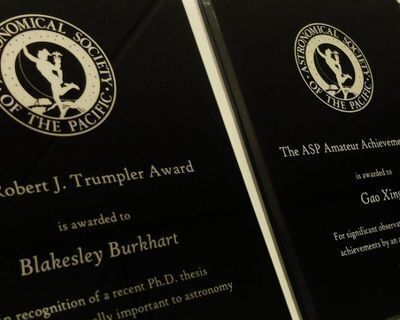Past recipients
The Priscilla and Bart Bok Awards are given jointly by the ASP and the AAS. The main criterion for selecting the two annual Bok Award winners is scientific merit. Observational, instrumental, theoretical, and interdisciplinary projects involving physics, mathematics, computer sciences, and engineering in support of astronomy are eligible. The awarded funds are intended to be used by the recipients to further their education and research efforts, and are augmented by support for travel to the next winter meeting of the AAS.
First- and Second-prize Bok awardees listed for each year, as selected at the annual Intel International Science and Engineering Fair (ISEF). Supported by funds from the National Science Foundation (NSF) in a grant to the Astronomical Society of the Pacific (ASP) and the American Astronomical Society (AAS).
2017
Cormac Larkin, Colaiste an Spioraid Naoimh, Ireland
Case Study of Data Mining in Observational Astronomy: The Search for New OB Stars in the Small Magellanic Cloud
Erica Sawczynec, Kihei Public Charter High School, HI, United States of America
Determining the Ages and Distances of Open Clusters
2016
Shashank Dholakia and Shishir Dholakia, Adrian C Wilcox High School, Santa Clara, California
A Search and Exploration of Multi-Exoplanet Systems Using Novel Photometric and TTV Algorithms for the K2 Mission
Camille Virginia Yoke, Maggie L. Walker Governor’s School, Richmond, Virginia
Constructive Interference of Seismic Surface Waves Antipodal to Crater Impact Sites on Terrestrial Bodies
2015
Shashank Dholakia and Shishir Dholakia, Adrian C Wilcox High School, Santa Clara, California
A Search for Exoplanets in the Open Star Clusters Messier 35 and Koposov 62 Using A Novel Large-Scale Photometric Algorithm for the “Crippled” Kepler Mission
Maxime Horlaville, Jeremiah Knockaert, and Quillere Manon, Lycee La Mennais, Guerande, France
Detection of Cosmic Particles Using Balloons
2014
Luhong Li, John L. Miller Great Neck North High School, Great Neck, New York
Velocity Gradients in Relation to Spatial Scales of Star-forming Dense Cores in the Perseus Molecular Cloud
Coleman J. Kendrick, Los Alamos High School, Los Alamos, New Mexico
3D Hydrodynamic Simulation of Classical Nova Explosions
2013
Arjun Raghavan, Chapel Hill High School, Chapel Hill, North Carolina
Photometric Evidence of Changes in Pulsation Characteristics of Hot Subdwarf B Stars
Michaela Brchnelova, Gymnazium Hubeneho 23, Bratislava, Slovakia
X-ray Measurements of Tycho Supernova Remnant’s Dynamics
2012
Piper Michelle Reid, Dripping Springs High School, Dripping Springs, Texas
Photometric and Spectroscopic Analysis for the Determination of Physical Parameters of an Eclipsing Binary Star System
Henry Wanjune Lin, Caddo Parish Magnet High School, Shreveport, Louisiana
A Generalized Holographic Model of Cosmic Accelerated Expansion
2011
Benjamin M. Clark, Penn Manor High School, Millersville, Pennsylvania
The Close Binary Fraction: A Bayesian Analysis of SDSS M Dwarf Spectra
Brian R. Graham, Southridge High School, Beaverton, Oregon
The Effect of Tracking Error on the Measurement of Exoplanet Light Curves
2010
Andrei V. Nagornyi, Stuyvesant High School, New York, New York
New Morphological Features for Automated Classification of Galaxy Images Obtained from Deep Space Surveys
Evan H. Fletcher, Kalamazoo Area Mathematics & Science Center, Galesburg, Michigan
Reducing the Computation Time of an N-Body Galactic Simulation
2009
Keith Austin Hawkins, Canton, Ohio
A Time-dependent Impact Parameter Model Sheds light on the Evolution of Galaxy Morphology in compact Clusters of Galaxies
Caroline Wurden, Los Alamos, New Mexico
Determining the Orbital Elements of Minor Planet 23265
2008
David Alex Rosengarten, John L. Miller Great Neck North High School, Great Neck, New Yorkl
Rotation Curves in Five Dimensions
Matthew James Walentosky, Oil City High School, Oil City, Pennsylvania
New Components in Accretion Disks: Evolution of the Lightcurve in WZ Sge
2007
Temple Mu He, Troy High School, Troy, Michigan
Period Analysis of Cataclysmic Variable X10 and Its Implications on the Origin of Low States
Emily Brook Petroff, Oregon Episcopal School, Portland, Oregon
Variation in Star Formation Rate from Galaxy Cluster Center for cl1037
2006
Hsin-Yu Chen, Taipei First Girl High School
Magic Mirror for Galaxy Clusters
Philip Mocz, Mililani High School, Mililani, HI
Group Analysis to Pattern Discovery in Stellar and Galactic Distributions
2005
Gabrielle Alyce Gianelli, Lake Highland Preparatory School, Orlando, FL
Fractal Dimension Analysis of Putative Martian Coastlines
Anand M. Palaniappan, David H. Hickman High School, Columbia, MO
A New Algorithm for Multiple Hypothesis-based Tracking and Discovery of Potentially Hazardous Near Earth Objects
2004
Eric M. Sauder, Hempfield High School, Landisville, PA
Relationship Between Sunspots and Solar Flares
Julie Ann Krugler, Grosse Pointe North High School, Grosse Pointe, MI
In Pursuit of Population III
2003
Lisa Doreen Glukhovsky, New Milford High School, New Milford, Connecticut
A Rapid, Accurate Method of Determining the Distance to Near-Earth Asteroids
Jonathan Nicholas Sick, Queen Elizbeth High School, Calgary, Alberta
Development of an Adaptively Controlled Telescope
2002
Matthew Douglas Apau Jachowski, Maui High School, Kahului, Hawaii
Effect of Observation Timing on Initial Orbit Determination Accuracy
Harish Gautam Khandrika, La Jolla High School, La Jolla, California
Evidence for Decay of 44Titanium to 44Calcium in Supernova Remnant Cassiopeia A.
2001
Sabrina Curie Snell, School Without Walls, Washington, District of Columbia
The Optical Divide
Michael Barynov and Aliaksei Akulionak, Lyceum #2, Minsk, Belarus
Improved System of Radio Observations of Meteors
2000
Francis Boulva, College Jean-de-Brebeuf, Montreal, Quebec, Canada
Cosmic Bubbles Improving Hi Shell Detection Around Massive Stars
Daniel Alan Perley, Socorro High School, Socorro, New Mexico
Dynamic Formation of Tidal Structure in Interacting Galaxies as Determined by Newtonian Model Computer Simulations: Phase II

